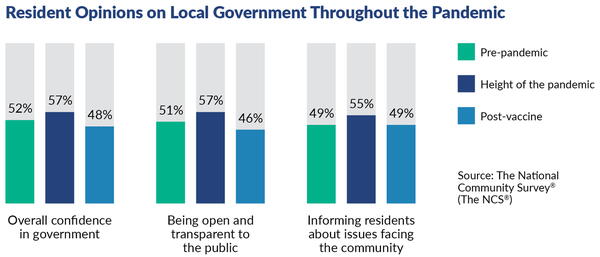
There are dozens of competing goals that local government leaders have to manage. Knowing what’s most important can be difficult to recognize. But a recent analysis boils down the top 10 most important community priorities according to residents. Officials who understand these prime concerns can achieve greater success in planning and decision-making by knowing exactly what community members want.
The findings come from National Research Center (NRC), the proprietary laboratory of survey and data scientists at Polco, a community engagement and civic analytics company. Researchers analyzed a nationwide, 30-year database of resident opinions alongside public community data to pinpoint what matters most to Americans today. Life has been unpredictable in recent years, which has influenced what people think is important. Some results are surprising.
10. Aging in Place
The older demographic will soon become the majority in the United States. The U.S. Census Bureau estimates people over 65 will outnumber children under 18 by 2034. The unprecedented population shift will restructure what communities look like.
As we age, we require quality access to health care, suitable housing, activities, transportation, and other necessities. These resources allow us to stay home without relying on others for help. Data show just how important it is to maintain independence with aging.
The Community Assessment Survey for Older Adults (CASOA) by NRC at Polco captures older adults’ opinions on livability. Results reveal that 84% of residents plan to remain in their community throughout retirement, highlighting that the majority of people plan to stay put as they age.
Unfortunately, many older adults are forced into long-term care or have to move from cities where services are unavailable. Governments that don’t facilitate aging in place now are already behind as Baby Boomers, the second-largest generation, move into their older years.
“This is a population [that governments] never intentionally planned for. But as our communities are aging, it’s now a very important group to pay attention to,” said Michelle Kobayashi, principal research strategist for Polco.
9. Health and Wellness
Health will always be a key concern for community members—but even more so today.
“If the pandemic has taught us anything, it’s that the health and wellness of our residents is a major factor in community livability,” Kobayashi said.
The National Community Survey (The NCS) by NRC at Polco asks residents their opinions about their city or town where they live. The NCS results say most people rate their communities positively for fitness and recreation opportunities. However, results also display a need for better access to healthy food, affordable quality health care, mental health care, and preventative services. Ratings in all these categories declined significantly from 2021 to 2022.
Kobayashi says even though medical and food needs are not directly part of local government’s role, it’s important to be proactive in ensuring health-related resources are available.
8. Natural Environment
Many residents desire access to green space and nature. For instance, some “amenity migrants” move to places with better access to the outdoors. But The NCS results show only around 60% of residents approve of natural land preservation, cleanliness, and open space in their communities.
Getting on board with natural environment trends can make your community more desirable to residents. The blue and green infrastructure movement, for example, incorporates water, plants, grass, and trees into urban areas. The 15-minute city movement ensures communities have access to necessities within that short drive timespan.
7. Education
Education has always been a top priority for American residents. But students and teachers alike struggled with remote learning throughout the pandemic. One study discovered students lost one-third of the school year during the height of Covid.
“The pandemic really did a doozy on education,” Kobayashi said.
Residents’ approval of education in the United States hovered around 70% on The NCS for many years. Then satisfaction rates plummeted after 2020. Many initially thought the drop in satisfaction with education might have been temporary, but the trend continued into 2022.
To turn things around, Kobayashi suggests an emphasis on teaching twenty-first century skills. “The day of working on conveyor belts and construction lines is over,” she said.
Training kids and adults in critical thinking, cultural competency, communication, technical literacy, collaboration, and creativity will help align skills in modern day jobs and improve the decline in satisfaction in education.
6. Land Use
Land use deeply influences the quality of a community. How land is utilized impacts economic development, affects transportation, and determines the types of housing and population density, among many other effects. It can change the activities and the look of a place. For example, reducing agricultural lands for more urbanization will change the view and the type of work available.
Land use is also where governments have the most power to affect outcomes with regulations and policy changes. “Land use always has to be on this list because governments have so much control over the quality of livability through how you design a community and land use policy,” Kobayashi said.
That said, The NCS ratings for land use often score low. About 50% of residents say growth is well-planned in their neighborhoods. About 40% feel positive about residential and commercial growth, as well as the variety of housing options. And only about 30% approve of the availability of quality affordable housing.
5. Public Trust
“Local government operates based on trust between residents and public servants. It’s difficult to build and so easy to lose,” said Matt Fulton, senior advisor of national engagement for Polco and a former city manager for over 30 years.
Unfortunately, Americans are losing faith in local government.
Trust in local government went up during the pandemic; residents gained more appreciation for public services during the crisis. That changed over the last two years partially due to misinformation and polarization. Overall confidence in local government decreased from around 56% to 48% on The NCS from 2020 to 2022.
Residents want and expect inclusion in improving their community. Engaging community members in decision-making to reach a shared solution will start to rebuild lost trust.

4. Infrastructure
Residents and businesses are highly concerned with infrastructure. Infrastructure affects the big and little things in our daily lives, the quality of our internet access, the safety of our roads, and the water we drink.
“It’s one of the most important aspects of building a strong community,” Fulton said.
Polco’s American Rescue Plan Act (ARPA) Engagement Package is a series of surveys that ask residents and businesses where to put relief funds to best use. Both the ARPA Package and The NCS say the top three infrastructure priorities include drinking water, roads and bridges, and road safety. Access to reliable broadband has also become important post-pandemic.
“If your infrastructure needs are not met, then you will find that all other aspects of the community will be impacted, as well,” Fulton said.
3. Safety
Safety will always be a top need and is often the number one priority for many people. But residents’ priorities have shifted with other stressors, such as inflation and other day-to-day life needs.
Trust in police has also declined post-2020. Fulton says a lot of outside forces influence public opinion of police services. “It’s a really trying time for law enforcement,” he said.
But the decline in trust hasn’t taken away the essential need for safety services, which is why it still ranks at the top of the list.
The National Law Enforcement Survey (The NLES) by NRC at Polco measures resident opinions toward police and sheriff services. Top public safety concerns include drug abuse, DUIs, traffic problems, burglaries, theft and robberies, and domestic violence.
2. Community
The pandemic deepened isolation and now more people are craving time with their friends and family. This coupled with more polarization and racial tensions has more people valuing a sense of community.
“A lot of cities are struggling with building communities that are strong, that are unified, and have solidarity,” Kobayashi said.
Humans are social creatures and community creates a sense of belonging and connects us to others. It fosters resiliency and is also linked to better mental and physical wellbeing. Local governments can improve a sense of community by throwing events and engaging residents in decision-making.
“We have seen a lot of movement in local government, with citizen academies, community liaisons, and forming diversity, equity, and inclusion task forces,” Kobayashi says.
1. Economic Health
American residents and businesses both say economic health is the top priority for their communities. People are uncertain about their own economic futures, taking care of their families, and affording their homes with so many broader economic unknowns.
Traditionally, residents are often less satisfied with employment opportunities, cost of living, well-planned growth, and downtown vibrancy in their communities, according to The NCS.
Sometimes local government practitioners express that they don’t have power over the health of their local economy. But Kobayashi says governance and economy are deeply entangled, especially with a sales tax that helps fund local governments.
She says public-private partnerships and building stronger relationships with chambers of commerce can help local governments influence economic health.
Americans’ top priorities reflect the changes and stressors of today. Tuning into residents’ needs helps narrow your focus on the most pressing concerns. The knowledge brings clarity to goal setting when so many other distractions pull at your attention. In the end, understanding what your community members want improves problem-solving. When you align your actions with what residents want, you build trust and make the most effective change.
“Given all of the complex and evolving challenges facing all communities, understanding resident priorities, needs, and expectations to help inform important local decisions is key to building a place where people want to invest,” Fulton said.

JESSIE O’BRIEN is the head copywriter at Polco. Polco makes community engagement accurate and reliable. Hundreds of government leaders trust Polco for insights from surveys and data analytics on one easy-to-use online platform.
New, Reduced Membership Dues
A new, reduced dues rate is available for CAOs/ACAOs, along with additional discounts for those in smaller communities, has been implemented. Learn more and be sure to join or renew today!
